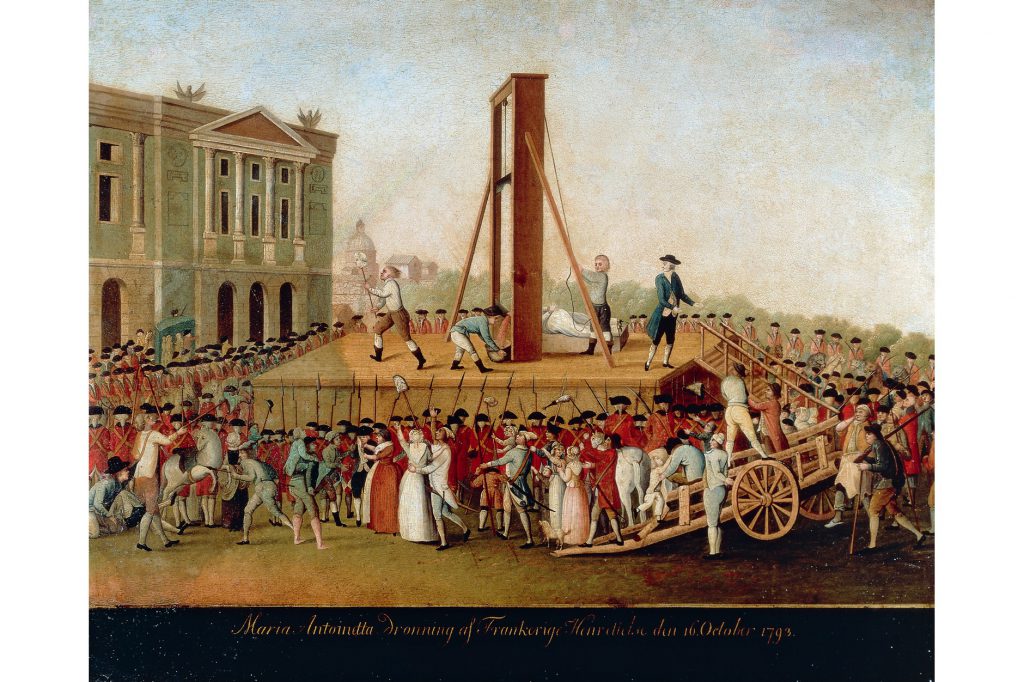
Two and a half months before her execution, at two in the morning, the Queen along with her daughter and sister-in-law were suddenly awakened and informed that the Queen was to be transported to the prison of Conciergerie. Without protest, Marie Antoinette got dressed and bid farewell to her family members. Then, without looking back, she left the temple. Fifteen minutes later, the Queen arrived in front of the grim towers of the Conciergerie, where she was registered under the name of “The Widow Capet” and became its 280th prisoner.5 She was led by the jailers to her new quarters. It was a dungeon of fifteen square meters with walls covered with an old cloth stained by humidity. It also had a narrow window at ground level that let in a pale light. Her only furniture consisted of a camp bed, two straw seat chairs, a convenience chair, and a bidet. Only a screen shielded her from the gaze of her guards and gave her no privacy at all. An assigned maid did everything she could to improve the Queen’s conditions during captivity.6

Alexander de Rougeville was loyal to the Republic at the beginning of the revolution; however, after he witnessed the Queen’s misfortune, he decided to help her to freedom. He had formerly been part of the Comte de Provence’s military establishment and was one of the officers who had protected her on June 20, 1792. That day, angry mobs broke into the Tuileries and forced the King to acknowledge the Republic. In addition, Marie Antoinette was insulted and called a traitor of France. In early September, he accompanied the royal family’s jail administrator Jean-Baptiste Michonis to the Conciergerie with two carnations pinned to his lapel. A plan called the Carnation Plot was attempted to aid the Queen to flee the country. Marie Antoinette picked up the flower and inside, the petal concealed a tiny note, which the Queen attempted to answer by pricking out a message with a pin. However, the gendarme on duty noticed her actions, took the incriminating evidence, and gave it to his immediate superiors. The name of the plot was taken from a flower that a certain Rougeville dropped at the Queen’s feet in her cell. The idea was for Marie Antoinette to escape to the château of Madame de Jarjayes. She was the Queen’s lady in waiting and her husband was General de Jarjayes, a loyal follower of the royal family. The Queen would then be transported to Germany, which was under the rule of Austria, Marie Antoinette’s homeland. The plot failed, but before the Republic could send the guards to capture him, Rougeville managed to escape.7
In the former Grand Hambre of the Palais de Justice, the Queen of France appeared before the Revolutionary Tribunal dressed in black and wore a widow’s bonnet in white lawn and trimmed with black mourning crepe. The Republic gave her lawyers less than a day to prepare a defense. One of the accusations against her was that she had been one of the instigators of the Champ-de-Mars massacre of July 1791, and that she had sent money out of the country to her brother, the Holy Roman Emperor. In addition, she was accused of scandalous conduct with her son, and that she had instigated most of the crimes that Louis XVI had committed. Marie Antoinette refused to respond to any charges. However, Marie Antoinette believed that she was innocent of these crimes and did everything within her power to save the monarchy as she conceived it. The entire trial started from October 15, 1793 at eight in the morning and ended on October 16 at four-thirty in the morning.8

On October 16, 1793, at four-thirty in the morning, Marie Antoinette was declared guilty of the three main charges of having secret agreements with foreign powers, of shipping money aboard to Austria, and of conspiring with these powers against the security of French. After ten weeks in the Conciergerie, the Queen’s incarceration came to an end. She was sentenced to death by guillotine and yet she remained impassive and simply shook her head at the verdict. As stated by Chauveau-Lagarde, Marie Antoinette showed true courage and was void of any negative emotion.9 Once returned to her cell, the Queen wrote a farewell letter to Madame Elisabeth, her sister-in-law. During the preparation for her execution, Rosalie witnessed the planned humiliation carried out on Marie Antoinette. First, she was obliged to prepare herself under the gendarmes’ watchful eyes. When she attempted to undress in a little niche between the wall and the bed, she signed to Rosalie to shield her. However, one of the men came around and stared at her. The humiliation continued when Charles Henri Sanson came and hacked off her thin white hair with enormous scissors. Marie Antoinette was also told her hands must be bound, even though the late Louis XVI hadn’t had his hands bounded. The next humiliation occurred when she was overcome with weakness and asked to have her hands unbound and squatted in the corner. Having relieved herself, she meekly held out her hands to have them bound again.10
The day was fine and slightly misty, as huge crowds lined the route to the Place du Carrousel’s guillotine and listened to the cries of the escort: “Make way for the Austrian woman!” and “Long live the Republic!”11 Mainly the crowd heard these cries with satisfaction. By the time the cart reached the Place du Carrousel, she was sufficiently in command of herself to step down easily. Stepping lightly “with bravado,” she sprung up the scaffold steps despite her bound hands, and paused only to apologize to her executioner for stepping on his foot.12 So she went willingly, even eagerly, to her death. The head of Marie Antoinette, desired by the leaders of the French Revolution, was cut off cleanly at 12:15 on Wednesday, October 16, 1793, and was exhibited to a joyous public.
On the very day of the execution, the Queen’s mutilated body was taken to the small cemetery of the Madeleine, where the King’s body had been left nine months earlier. On November 1, a gravedigger buried the Queen’s remains and sent the following note to the multiple authorities. “The widow Capet. 6 livres for the coffin. 15 livres, 35 sols for the grave and the gravedigger.” These words described the funeral of the last Queen of France.13 With the restoration of the monarchy, on January 18, 1815, the remains of the royal bodies were exhumed with the help of Pierre Louis Desclozeaux, an old lawyer who lived at 48 rue d’Anjou. He remembered the two interments and had subsequently tended the sites. He created a garden out of the area and planted two weeping willows as a commemoration. The bodies were then briefly held at the house in the rue d’Anjou. Prayers were said before they were sealed in new coffins with appropriate inscriptions of the majesty and titles of the occupants. On January 21, 1815, a formal procession led the coffins to the Saint Denis cathedral.14 Commemorative statues of Louis XVI and Marie Antoinette were built in the cathedral and their remains were reburied in the Bourbon vault.15
No longer considered one of history’s greatest criminals, the last Queen of France today arouses interest and compassion. After her death on the scaffold, Marie Antoinette entered the world of legend and became a mythical figure.16 Being a scapegoat for the revolution, the Republic’s political decision for her execution united France. Despite being a sacrifice for the French, she never lost her composure and retained her image as a dignified Queen until the last moment of her life.17
- Evelyne Lever, Marie Antoinette: The Last Queen of France (NY: Farrar, Straus and Giroux, 2000), 304-305. ↵
- Evelyne Lever, Marie Antoinette: The Last Queen of France (NY: Farrar, Straus and Giroux, 2000), 213. ↵
- Evelyne Lever, Marie Antoinette: The Last Queen of France (NY: Farrar, Straus and Giroux, 2000), 250-259. ↵
- Evelyne Lever, Marie Antoinette: The Last Queen of France (NY: Farrar, Straus and Giroux, 2000), 287-290. ↵
- Evelyne Lever, Marie Antoinette: The Last Queen of France (NY: Farrar, Straus and Giroux, 2000), 291-292. ↵
- Evelyne Lever, Marie Antoinette: The Last Queen of France (NY: Farrar, Straus and Giroux, 2000), 292. ↵
- Evelyne Lever, Marie Antoinette: The Last Queen of France (NY: Farrar, Straus and Giroux, 2000), 293-294. ↵
- Evelyne Lever, Marie Antoinette: The Last Queen of France (NY: Farrar, Straus and Giroux, 2000), 299-304. ↵
- Antonia Frazer, Marie Antoinette: The Journey (NY: Doubleday, 2001), 435-438. ↵
- Antonia Frazer, Marie Antoinette: The Journey (NY: Doubleday, 2001), 438-440. ↵
- Antonia Frazer, Marie Antoinette: The Journey (NY: Doubleday, 2001), 439. ↵
- Antonia Frazer, Marie Antoinette: The Journey (NY: Doubleday, 2001), 440. ↵
- Evelyne Lever, Marie Antoinette: The Last Queen of France (NY: Farrar, Straus and Giroux, 2000), 305. ↵
- Antonia Frazer, Marie Antoinette: The Journey (NY: Doubleday, 2001), 447. ↵
- Antonia Frazer, Marie Antoinette: The Journey (NY: Doubleday, 2001), 457. ↵
- Evelyne Lever, Marie Antoinette: The Last Queen of France (NY: Farrar, Straus and Giroux, 2000), 308-309. ↵
- Antonia Frazer, Marie Antoinette: The Journey (NY: Doubleday, 2001), 453. ↵




80 comments
Jesslyn Schumann
This article captured the timeline of the Queens trial and death perfectly. The author really highlights the conditions the Queen was in prior to her death and all of the things she had to endure. I did not realize that she was so mistreated during her time in jail, but also how eager she was to go to her death. The little details within this story allow the readers to understand how important her death was.
Andrew Ponce
The article comprises the death of Marie Antionette and never bores the reader throughout the story. The author keeps the reader engaged and interested, through very exciting and engaging vocabulary. The intro to the article alone is what catches the reader on a strong hook. The topic as well seems to captures the reader as many people know of Marie Anionette, however not many know in detail how she was taken to death, Very educational and interesting article!
Victorianna Mejia
The timeline of this article does match up to our lectures during the French Revolution. We even spoke about Marie Antoinette and Louis XVI in class.This article was an excellent read! Marie Antoinette was a respectable woman even though she was fearful for her life. She held herself high and proud without complaint. The article was interesting and gave details that I would have not known without this reading. It was a scary time for women and she is now one who can be looked up to as a role model towards her death.
Vianne Beltran
Hi Amelia,
I appreciated your article as it dispelled some of the common misconceptions people today have regarding Marie Antoinette. I feel like history has painted her more sinister than she actually is. While there are valid criticisms of her husband’s rule I don’t think she had any true power in it. Her treatment leading up to her death was undeserved I think.
Brissa Campos Toscano
Hi Amelia! I enjoyed reading your article. The first paragraph made me want to read more, and it captivates the reader in no time. I like how you structured your sections, adding details to make the reader context. I also found it interesting how you found such an exciting topic; usually, they explain that the royal family was captured in history books. Later on, the heads of Louis XIV and Marie Antoinette were taken, showing that the Republic had won. I love how you give us this piece of history which can help us give more context to the death of Marie Antoinette and how she did have a trial and how even though she was not innocent, she did have an unfair treatment during imprisonment.
Nooraldeen Aldrees
The author does a very good job introducing the story by going briefly on the idea of article and asks a question about the conclusion provided in the summary. Then, she does a very great job in diving in in more details, by mention different quotes in different scenery of the story. She gave me a visual of the story by the good use of quotation and description of different stages of the execution. Good Job. I enjoyed the article.
Claire Saldana
This was a good article to read to get a look at her perspective and the role she played in this event. She probably did help Louis with these crimes and encouraged him. She also could have had no idea and was just living her own life and people took that as a bad thing. I felt like I was watching a movie of her execution with every detail that was included especially about her cell. Very well done.
Phylisha Liscano
This was very interesting and a well written article. I had very little knowledge of the subject before reading but I enjoyed getting the chance to read more about it. Growing up i had heard of Marie Antoinette but your article provided so much information. Taking a look I can tell lots of research was put into your article and you provided lots of information. Overall great article and an excellent topic.
Carlos Hinojosa
The French Revolution was bloody and most points of its reign unnecessary and cruel. I truly believe these were one of the points during that time. I didn’t disagree with the idea of her being executed because I personally believe it’s better to cut out a root instead o just taking it’s petals and stem. However, I do believe it was cruel what they did to her and how they treated her. She should have still been given the respect of a queen.
Gisselle Baltazar-Salinas
I thought this article was extremely well written and captivating . I especially enjoyed the intro and starting off asking questions only to answer them later. In doing so I was engaged with the entire article curious to know what will happen next. This really made the story come to life. I had only known or heard her name with the phrase “let them eat cake”, but I never knew her story before reading this article. I am left intrigued to do more of my research.